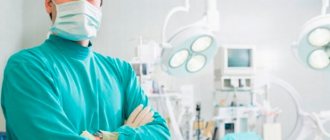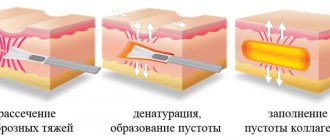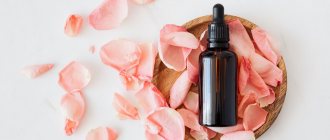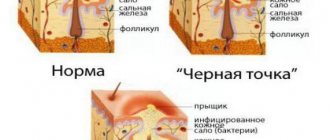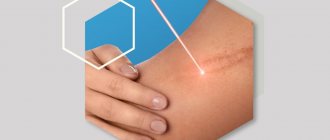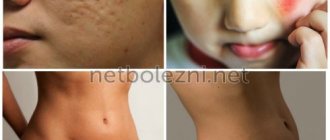From this article you will learn:
- how to get rid of acne spots,
- how to remove acne scars on face,
- what to do if scars appear after chickenpox.
The article was written by a specialist with higher medical education.
After acne and chickenpox, marks often remain on the face that spoil the appearance of the skin. Just 10-15 years ago it was difficult to help such patients, but modern hardware cosmetology can almost completely solve this aesthetic problem. In addition, chemical peels, as well as a number of pharmaceuticals and cosmetic products, may be useful.
Acne marks can be divided into 3 main types - 1) post-inflammatory erythema or redness, 2) post-inflammatory hyperpigmentation or brown spots, 3) atrophic scars, which very often form at the site of large inflammatory lesions in acne, as well as after chickenpox , 4) keloid scars, which are much less common. Therefore, how to remove acne marks on the face will primarily depend on the type of lesion.
Post-inflammatory erythema –
Post-inflammatory erythema is the most common type of blemish after acne. Such spots range in color from pink to bright red or purple. They are formed in place of papules and pustules (pimples) - due to persistent expansion of blood capillaries, and this is more typical for people with fair skin. You can do nothing about these spots and they will disappear on their own, but this may take several months or even longer.
Post-inflammatory hyperpigmentation –
Such pigment spots have a brown tint and are associated with excessive accumulation of melanin pigment in the area of the inflamed area of the skin. Such spots often form during periods of high solar activity. Moreover, in place of acne in the form of papules without pus, weakly pigmented spots usually appear, and in place of pustules with pus, hyperpigmented spots often appear.
Atrophic scars (after acne or chickenpox) –
Atrophic scars appear as depressions on the surface of the skin (minus tissue). They are formed due to disruption of collagen synthesis in inflamed areas of the skin. These acne scars usually remain after large inflammatory lesions, such as nodules or cysts, have healed. Sometimes scarring can disrupt the synthesis of the melanin pigment, which at the same time will lead to hypopigmentation of these areas of the skin. Acne scars and chickenpox scars are treated the same way.
Below we will sequentially analyze the treatment of all these forms.
How to get rid of red spots after acne -
We have already said above that such red spots after acne are more correctly called post-inflammatory erythema. Its formation at the site of resolved acne is associated with a persistent expansion of blood capillaries at the site of inflammation. Accordingly, how to remove red spots from acne lies solely in the use of methods that allow you to destroy dilated capillaries.
First of all, we are talking about the use of 2 types of special devices: pulsed lasers using liquid dyes, as well as IPL devices. They work in a similar way: light pulses penetrate to a shallow depth through the surface layers of the skin and are absorbed by hemoglobin in the blood. This leads to the release of a large amount of thermal energy in the dilated capillaries, which leads to their coagulation. As a result, the skin color at the site of erythema is gradually restored to normal.
Below we will look at examples of effective devices for erythema after acne.
Pulsed dye lasers –
Pulsed dye laser is considered the gold standard treatment for post-inflammatory erythema. These lasers most often operate at a wavelength of 585 nm, although long-pulse dye lasers (with wavelengths between 595 and 600 nm) also exist. The latter includes the Vbeam Perfecta laser, which is very effective for the treatment of erythema after acne, and we would put it in 1st place - in comparison with all other devices listed below.
An example of one of the studies (“Acne erythema improvement by long-pulsed 595-nm pulsed-dye laser treatment: a pilot study” Lee, Kim, Park, 2008). This study shows that 2 sessions of long-pulse dye laser (4 weeks apart) lead to lasting improvement in 90% of patients. Moreover, the number of lesions after the 1st session decreased by approximately 24.9%, and after the 2nd session - by another 57.6% (in some cases, the erythema persisted, but the size of the spots in any case became smaller).
This laser also helps reduce atrophic scars. Therefore, if you not only need to remove acne scars in the form of red spots, but also have the goal of getting rid of acne scars, this laser may be a good option.
Potassium titanyl phosphate (KTP) laser –
KTP lasers operate at a wavelength of 532 nm (an example is the Compact laser). These lasers work well in reducing post-inflammatory erythema, but are still slightly inferior to pulsed dye lasers. This type of laser has virtually no effect on the production of collagen in the dermis, so if you also have acne scars, this laser will not be able to help reduce them.
However, in addition to the treatment of post-inflammatory erythema, KTP lasers can also be used to treat papulopustular acne (pimples). The fact is that the wavelength of 532 nm is absorbed by the porphyrins of the bacteria P.acnes, which leads to the destruction of their bacterial walls. Thus, if, in addition to post-inflammatory erythema, you also have active foci of inflammation, then the use of a KTP laser may be preferable (24stoma.ru).
Devices for IPL therapy –
Intense pulsed light (IPL) is an option for treating post-inflammatory erythema in patients with acne. IPL devices differ from lasers in that they do not operate at any one wavelength, but simultaneously in the range from approximately 400 to 1200 nm. For the treatment of post-inflammatory erythema, the FDA has approved the use of the IPL module of the Lumenis M22 device. Moreover, the clinic must have special “vascular” light filters for the IPL module (530-650 and 900-1200 nm).
In general, IPL devices are quite effective for treating red acne marks, but they are still inferior to pulsed dye lasers. For example, a pulsed dye laser may require only 2 sessions, while persistent erythema on an IPL device may require 3 to 5 sessions. In addition, IPL devices can also be used to treat active inflammatory foci of acne, but for this, a different light filter (400-600 nm) is used, designed specifically for acne therapy.
Nd:YAG lasers –
Post-inflammatory erythema following acne is associated more with superficial blood vessels, but this laser penetrates deeper than is usually necessary. Therefore, Nd:YAG lasers are not very effective for common post-inflammatory erythema. The only exception would be the treatment of erythema, which was caused by the expansion of blood capillaries in the deep layers of the dermis. An example of such a laser would be the Cutera Genesis, which operates at a wavelength of 1064 nm.
Nd: YAG lasers such as "Cutera Genesis" for acne patients are more interesting because they are able to destroy the sebaceous glands using heat, which will significantly reduce oily skin and acne symptoms. In addition, this type of laser will also be effective for treating atrophic acne scars, because its effect stimulates collagen synthesis in the dermis.
Fractional RF devices –
Such devices are a novelty in modern hardware cosmetology. Devices for fractional radio wave lifting (fractional RF lifting) are also very effective for treating red spots after acne. One of the best devices can be called the “Venus Viva” device (made in Canada/Israel). The fractional effect in this device is provided by a special NanoFractional RF applicator. With its help, you can effectively treat not only red spots after acne, but also hyperpigmented spots associated with melanin deposition.
In addition, fractional exposure to the skin simultaneously stimulates collagen synthesis in the skin, which will not only increase its elasticity and smooth out wrinkles, but also significantly reduce the depth of atrophic scars after acne. In addition to Venus Viva, there are several other manufacturers of fractional RF devices. For example, there is a fractional “Sublative RF” handpiece that comes with the eTwo™ and Elos Plus™ devices.
Important: There are many acne spot treatment products advertised now that you can buy at the pharmacy. Such skin lightening products (based on retinoids, azelaic acid, tyrosinase blockers, etc.) only help with brown age spots. In addition, for post-inflammatory erythema, you should not do chemical peels, because you will get the opposite effect.
How to remove brown acne spots -
The appearance of brown pigment spots after acne is associated with excessive formation of the melanin pigment.
This process is called post-inflammatory hyperpigmentation, but usually such spots also go away on their own (within 3 to 24 months). To avoid the appearance of foci of hyperpigmentation at the site of acne, patients with acne should always use non-comedogenic sunscreens with an SPF of 30 during periods of high solar activity. How to remove acne spots on the face - this can be done either with the help of special cosmetics or with hardware methods. As for cosmetic products, in fact, most advertised products are either not effective at all for hyperpigmentation, or have very little effectiveness. The standard for the treatment of hyperpigmentation is an effect comparable to the use of 4% hydroquinone (it is currently banned in many countries due to its strong toxic effect).
The best remedy for dark spots after acne is
- Tretinoin (Retin-A cream, A-Ret Gel, etc.) – in a concentration of 0.05-0.1% promotes quite pronounced lightening of hyperpigmentation foci. Officially, drugs with tretinoin are not sold in Russia, but they can be purchased to order on the Internet. The price for a 20 g tube starts from 800 rubles. The disadvantage of products with tretinoin is that at the first stage of use they have an irritating effect on the skin.
- (USA) produces such a remedy for hyperpigmentation as “ADVANCED PIGMENT CORRECTOR”. This drug is applied precisely to areas of hyperpigmentation. It contains 0.3% salicylic acid, 1% hydroxyphenoxypropionic acid, 0.5% ellagic acid, etc. According to clinical studies, the effectiveness of this product is comparable to the use of 4% hydroquinone.
- A combination of 10% glycolic acid and 0.5-1% kojic acid gives a good effect for 1-2 months when used twice a day. This is an extremely effective combination, but you need to keep in mind that if you use products with only glycolic acid, it will take you longer to achieve a similar effect. (Spain) produces several interesting products for the correction of hyperpigmentation.
Depigmenting gel “KOJICOL PLUS” contains a combination of glycolic and kojic acids + alpha-arbutin, phytic acid and mulberry extract (this gel is used for moderate pigmentation, applied pointwise). Slightly stronger brightening gel "HIDROQUIN" - contains alpha-arbutin, ferulic acid, retinol, vitamin C + niacinamide (nicotinamide).It also produces 2 professional products (you can buy them only through cosmetologists). Firstly, this is “TARGET cream” based on retinol, alpha-arbutin, as well as tranexamic, kojic and citric acids. Secondly, this is “TARGET liposomal serum” (it contains azelaic acid, 4N-butylresorcinol, retinol, glycyrrhetinic acid, alpha-arbutin, niacinamide, white mulberry extract, ascorbyl glucoside, etc.). The products are applied locally to age spots.
- Preparations with azelaic acid (for example, Skinoren cream or gel) - they are quite effective against hyperpigmentation, but to achieve a pronounced effect you will need to wait about 5-6 months.
- The remaining components - components such as arbutin (alpha-arbutin), licorice root extract, mulberry extract, emblicanin, nicotinamide - are only minor components for the treatment of hyperpigmentation. As for the use of antioxidants (for example, vitamin C), they effectively reduce the severity of pigmentation that has developed as a result of UV irradiation, but they have a much worse effect on post-inflammatory pigmentation.
How to get rid of acne marks quickly -
If you decide to use products for external use (in the form of a cream, gel or serum), then quickly removing hyperpigmented spots will not work. How to get rid of acne marks in just 1-2 procedures - the achievements of hardware cosmetology will again help you with this. This can be done using IPL devices or lasers, for example, the same Lumenis M-22 device, which is approved by the FDA, including for the treatment of hyperpigmentation.
The Lumenis M-22 device is a multifunctional platform that combines both an IPL module and a ResurFX fractional laser. Depending on the severity of post-inflammatory hyperpigmentation, one or another module may be used at the discretion of the physician. ELOS devices can also be used, which combine 2 types of effects on the pigment spot (IPL + radio frequency energy), although they are not as effective.
Treatment of hyperpigmentation lesions using IPL –
Chemical peels –
This is another option for how to quickly cope with post-inflammatory hyperpigmentation. However, it is not as fast as hardware cosmetology, and not as effective. For example, peelings with mandelic acid can help you with this (improvement is achieved in approximately 55% of cases). Another option is peelings with a combination of glycolic and kojic acids, but such peels cannot be done for patients taking oral contraceptives, because. this will enhance pigmentation.
Another effective peeling for post-inflammatory hyperpigmentation is “AZELAC RU” from Mediderma. It contains a combination of azelaic, mandelic, phytic and ferulic acids, as well as 4N-butylresorcinol. In any case, it must be said that even a whole course of peelings is unlikely to completely remove all foci of pigmentation, but this will definitely improve the situation in about 2 months (Fig. 11).
Prevention Tips
- Wash your face at least twice a day
- Remove makeup before going to bed.
- Don't squeeze your pimples.
- Try to avoid the sun. Always wear sunscreen if you have to go outside.
- Watch your diet. It should be healthy and consist of whole grains, legumes, fresh fruits, vegetables, fish and nuts.
The above-mentioned remedies will help reduce the appearance of scars to a large extent, but nothing will make them disappear completely. Thus, it is best to try to treat acne as soon as possible to reduce the severity of the scars, holes, and pits that follow. And laser scar removal is a very expensive procedure, so it’s better to use natural remedies.
How to remove scars from acne and chickenpox -
Acne and chickenpox scars are atrophic (minus tissue), although keloid scars can sometimes occur after severe forms of acne. Scars after acne (as well as scars after chickenpox) are defects of the dermis and, accordingly, methods affecting the dermal layer of the skin will be used to correct them. According to the accepted international classification, all atrophic scars are divided into 3 main types -
- “ice pick” type scar,
- rolled scar,
- carriage-shaped scar.
The division of scars into types has clinical significance, because Different treatment methods show different effectiveness when dealing with different types of atrophic acne scars. Ice pick scars are narrow, deep, sharply defined scars, the bottom of which can reach deep layers of the dermis or even subcutaneous tissue. Rolled scar (also called groove-shaped) - has the appearance of a deep, long groove with a width of 4 to 5 mm.
Carriage-shaped scars are round to oval-shaped depressions with sharply defined vertical edges. According to statistics, “ice pick” scars make up about 60-70% (of the total number of acne scars), carriage-shaped scars - about 20-30%, knurled - about 15-20%. Chickenpox scars are exactly the same as acne scars and will be treated accordingly. Below we will focus on the most effective methods, but first we will list methods that are definitely not worth wasting time and money on.
Useless and of little use methods -
- special creams for scars such as contractubex or any other (just zero effect),
- cosmetics with retinoids and vitamin C (can only be used as a preparatory stage for hardware methods),
- filler injections (expensive, and the effect is temporary).
Homemade external remedies
If desired, you can make homemade ointments to get rid of scar formations. In terms of their effectiveness, they are no worse than ready-made pharmacy creams. Best recipes:
- You need to mix 1 tsp. honey with the same amount of ground cinnamon, and then apply the resulting thick mass to the cleansed problem areas. After 20 minutes, rinse off the product with warm water. The procedure is performed once a day, every other day.
- You need to mix 500 g of goose fat and ground Sophora japonica fruits, then steam the mixture for 4 days in a row (60 minutes every day). On the 5th day, apply the ointment to gauze and apply to the scars for 15 minutes.
- It is necessary to combine 400 ml of vegetable oil and 100 g of beeswax, and then keep the composition on low heat for 10 minutes and cool. Distribute the finished product over areas of skin with scar formations 2 times a day.
In addition, the cabbage-honey mask has good healing properties. To make it, grind the cabbage leaves in a blender and add 10 g of natural honey to the resulting pulp. Apply the product to the location of the scars and wash off with warm water after 2 hours. The procedure is performed twice a day for 3 weeks or 3 months.
TCA chemical peel –
Ice pick scars can be corrected well with trichloroacetic acid (TCA) peels, but this method should be avoided in patients with dark skin due to the high risk of hyperpigmentation. Conducting a medium peel will mean a TCA concentration of 40-50% (only in this case does damage to the papillary dermis occur), and anything below 40% is only a superficial peeling to the depth of the epidermis. Accordingly, we need a TCA of at least 40%.
It should be noted that such a high concentration means certain risks. Therefore, such peeling should only be done by a very experienced dermato-cosmetologist. Below you can see the result after 3 TCA 50% peeling procedures, where the intervals between procedures were 4 weeks. As you can see, a significant improvement has been achieved, and other methods can then be used (for example, laser resurfacing, or the method of perforation removal of individual scars).
TCA chemical peel (before and after photos)
Makeup as a method of correction
So, how to correctly correct your facial tone:
- Prepare the skin for applying makeup: wash with soft foam and then wipe your face with toner.
- Apply makeup base. It will even out the surface of the skin and subsequent products will be better distributed over the face.
- Use corrector precisely. Green is suitable for masking red marks. Then cover the skin with foundation or BB cream.
- Apply powder over the T-zone and blush on the cheekbones.
All of the above cosmetics should be selected taking into account your skin type. It is advisable to choose hypoallergenic and non-comedogenic formulations.
Laser facial resurfacing –
There are a huge number of types of lasers that can be used to correct acne and chickenpox scars, but we will try to systematize this information. All lasers for scar correction can be divided into 2 main categories (each of which in turn is divided into two more):
- ablative (traditional and fractional),
- non-ablative (traditional and fractional).
a) The best ablative lasers –
Ablative lasers seem to evaporate the surface layers of the skin, but at the same time they also affect the dermis, stimulating the formation of collagen in it. Those. The term “ablative” means that the laser action involves permanent damage to the surface of the skin. Traditional ablative CO2 lasers are extremely effective for correcting atrophic scars (50–80% improvement in scar condition is achieved after only 1 procedure), but such lasers have a high risk of complications and side effects.
This is due to the fact that traditional ablative lasers operate in continuous resurfacing mode (i.e., total damage to the entire surface of the skin in the treated area occurs). Due to the large number of side effects and long rehabilitation period, fractional type ablative lasers were developed. Their peculiarity is that they damage the skin fractionally (fragmentally), i.e. Between the damaged areas of the skin, intact areas remain, which will contribute to much faster healing.
One of the best ablative fractional CO2 lasers can be called “AcuPulse” (Lumenis, Israel), it operates with a wavelength of 10,600 nm. There are also ablative fractional erbium lasers (Er: YAG) - with a wavelength of 2940 nm. The effectiveness of CO2 and Er:YAG lasers is almost comparable, however, both of them may require 2-3 procedures (while a traditional ablative laser may require only 1 procedure).
I would like to note that the ablative fractional laser “AcuPulse”, if necessary, can also work in the mode of total resurfacing of the skin flap (i.e., act not as a fractional laser, but as a traditional one).
a) Non-ablative lasers (traditional and fractional) –
Non-ablative lasers (unlike ablative lasers) cause thermal damage only to the dermis and deep layers of the epidermis, and no damage to the superficial stratum corneum of the epidermis occurs at all. They stimulate the formation of new collagen in the dermis - as a result of which the scar rises to the surface. We have already said above that non-ablative lasers are also divided into traditional and fractional.
When we talked about the treatment of post-inflammatory erythema, we already talked about pulsed dye lasers (585 or 595 nm), KTP lasers 532 nm, and Nd:YAG lasers 1064 nm. They are precisely non-ablative traditional lasers. But besides them, it should also include Nd:YAG lasers 1320 nm, as well as diode lasers 1450 nm. Absolutely all of these lasers have approximately the same efficiency, which is quite modest.
Clinical studies show that after 1 treatment, the condition of scars improves by only about 20-30%. This means you may need 3 to 5 treatments to get optimal results. Of course, the effectiveness of non-ablative traditional lasers is much less than ablative lasers (both traditional and fractional). Well, the last type of lasers that we want to talk about are non-ablative fractional lasers, which include, for example, the FRAXEL RE:STORE laser.
Non-ablative fractional lasers differ from traditional lasers in that thermal damage to the dermis and deep layers of the epidermis occurs fractionally (i.e., there will be undamaged areas between the damaged areas). "FRAXEL RE:STORE" is an erbium fiber laser with a wavelength of 1550 nm. Clinical studies show that acne scars improve by approximately 50% after 1 treatment.
FRAXEL: before and after photos
A few important points regarding laser resurfacing -
You should understand that laser resurfacing will show different effectiveness for different types of atrophic scars. The main indications for laser resurfacing will be carriage-shaped and groove-shaped (knurled) scars. For example, if we take the FRAXEL RE:STORE laser, then on carriage-shaped scars it can show an improvement of up to 50% (for 1 procedure), groove-shaped scars - only up to 40%, and on scars of the "ice pick" type - there will be only improvement up to 25%.
The same will apply to any other type of laser, i.e. on scars of the “ice pick” type - any type of laser resurfacing will a priori be less effective. Therefore, you should understand that the number of laser resurfacing procedures that may be required will depend not only on the type of laser, but also on the type of atrophic scars on your skin. Carriage-shaped scars after acne are always easier to correct (as are scars after chickenpox).
Types of skin rashes
There are several types of acne that can appear on the back:
- blackheads, or open comedones, which are formed when the mouth of the hair follicle is blocked by sebum,
- papules, or pinkish bumps on the skin,
- closed comedones, or whiteheads, they appear due to the accumulation of subcutaneous fat in the hair follicle, which cannot come out,
- pimples, or pustules, pustules are papules on the skin filled with pus. Usually there is an inflammatory process around them, expressed by redness of the skin,
- internal pimples, which form deep under the skin and can become hard, forming large bumps that are painful
- Cystic acne occurs as a result of sebum clogging the inside of the follicle. This is a severe and painful form of acne, and as it heals, it leaves marks, scars, and scars on the skin.
Fractional RF lifting –
At the beginning of the article, we already said that such devices are effective against red spots after acne. But at the same time they are very effective against atrophic scars after acne or chickenpox. We recommend 2 devices for this. Firstly, the Venus Viva device (made in Canada/Israel), which must be equipped with a NanoFractional RF tip. Secondly, eTwo™ and Elos Plus™ devices from , which must be equipped with a Sublative RF fractional tip.
The fractional tips of these devices are supplied with disposable applicators with microneedles (electrodes up to 1 mm in size), with the help of which thermal damage is produced in the epidermis and dermis. The damage is fractional in nature, i.e. they are surrounded by intact tissue for rapid re-epithelialization of damage. Damage to the epidermis is microscopic and not noticeable; the main effect is realized in the dermis.
Thus, this is an ablative technique (with damage to the stratum corneum of the epidermis), but unlike laser resurfacing procedures, fractional radiofrequency lifting has a very short rehabilitation period and no side effects. The method is effective not only for atrophic scars, but also for the treatment of post-inflammatory erythema and hyperpigmentation. Below you can see photos before and after a course of 3 fractional RF lifting procedures.
Contraindications for use
Not everyone can use anti-scar ointments. The main prohibition against their use is an allergic reaction to any component included in the drug. In addition, you should refuse treatment with external anti-scar agents if:
- herpes;
- postoperative scars;
- localization of scar formation near the mucous membrane;
- suppuration near the scar;
- problems with blood vessels.
Many ointments cannot be used during pregnancy and breastfeeding. Before starting treatment, it is better to consult a dermatologist.
Using the Dermapen device or mesoscooter –
Dermapen works great where there is “minus tissue”, i.e. with atrophic scars. This is a fractional device that, using the mechanical movements of a nozzle with needles, causes microdamage to the skin. And the skin naturally reacts to damage by regeneration, i.e. collagen synthesis is stimulated. Depending on the number, depth and type of atrophic scars, the course of treatment may require from 3 to 6-8 procedures.
Dermapen device –
The first results can be seen 6-8 weeks after the first procedure, and the final result can be assessed only 3 months after the last procedure. The same applies to any other methods (for example, laser resurfacing). This is due to the fact that stimulation of collagen production in response to skin damage is delayed in time and increases gradually. You, of course, can purchase such a device and try to do the procedures yourself, but it will be more effective if the procedures are performed by a specialist.
Dermapen: before and after photos
The mesoscooter is a cheaper alternative to the Dermapen device. It works on the same principle - it leaves microdamages in the skin, but the damage is no longer applied strictly vertically, but at a changing angle (since the mesoscooter drum with needles rotates). This is not very good and can lead to roughening of the skin due to the production of abnormal scar collagen. Below you can see photos before and after 3 procedures performed at an interval of 4 weeks.
Mesoscooter: before and after photos
How to increase the effectiveness of these methods -
The effectiveness of using a dermapen or mesoscooter can be increased if you undergo special training. Clinical studies have shown that if the patient used topical retinoids for at least 1 month (optimally 2-3 months), the effectiveness of the method increased significantly. As retinoids you can use: products with pure retinol (at least 0.3-0.4% and up to 1%), as well as tretinoin 0.025%.
Products with the L-form of ascorbic acid with a concentration of 15% (instead of retinoids) can also be used, because they also stimulate collagen production in the skin. Another preparation option is injection mesotherapy in a cosmetologist’s office. In this case, several procedures are first carried out using nucleotides (DNA-RNA complexes) - an excellent Italian drug for this is “Plinest”. After this, several injection procedures with complexes containing matrikin peptides (they stimulate collagen production).
After such an injection preparation of 4-6 procedures, we move on to the dermapen or mesoscooter itself. We hope that our article: How to get rid of acne spots, acne scars and chickenpox was useful to you!
Sources:
1. Higher medical education of the author of the article, 2. Textbook on dermatology “Fitzpatrick's Dermatology” (8th edition), 3. American Academy of Dermatology (USA), 4. National Library of Medicine (USA), 5. “Cosmetic dermatology” (Bauman L.). 6. Clinical studies published at https://www.ncbi.nlm.nih.gov/.

